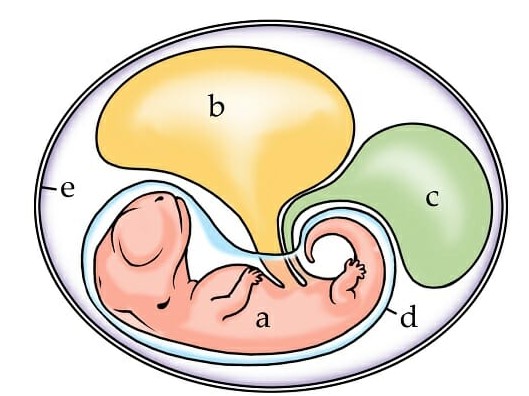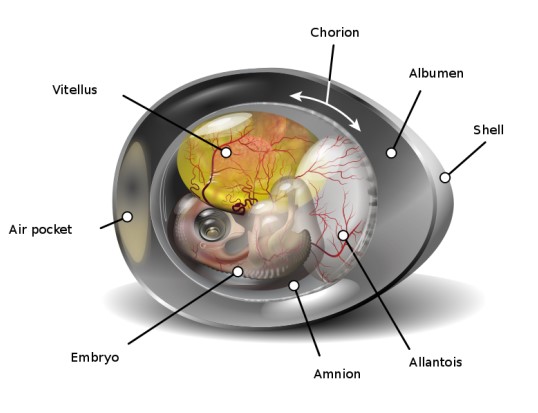The journey of life begins long before a baby takes its first breath. Within the protective confines of the womb, embryonic membranes play a pivotal role in ensuring the development and survival of the fetus. Among these membranes, the amnion and allantois are critical, yet they serve distinctly different purposes. Their contribution is fundamental to embryonic development, offering a fascinating glimpse into the complex processes that herald the beginning of life.
The amnion and allantois are embryonic membranes with unique functions and structures. The amnion surrounds the embryo, providing a cushioning amniotic fluid that protects and hydrates, while the allantois is involved in waste removal and the exchange of gas and nutrients. Although both structures contribute to the growth and well-being of the embryo, their roles and developmental pathways differ significantly.
Understanding the differences between the amnion and allantois reveals the intricate balance of systems that support life from its earliest stages. These membranes not only protect and sustain the embryo but also facilitate the formation of structures vital for postnatal life. Their evolutionary significance and biological roles underscore the marvel of embryonic development, a process that remains at the heart of developmental biology and medical research.

Amnion Explained
Definition and Function
The amnion is an embryonic membrane that forms a protective sac around the embryo during development. Its primary function is to cushion the embryo in amniotic fluid, a clear, watery liquid that provides a buoyant environment free from mechanical shocks. The amnion plays a critical role in maintaining a hydrated, temperature-stable environment, essential for the embryo’s growth and protection.
Origin and Development
The development of the amnion begins early in embryogenesis, shortly after the embryo implants in the uterine wall. It originates from the inner cell mass of the blastocyst, which differentiates into the epiblast and hypoblast. The cells from the epiblast fold to form the amniotic sac, encapsulating the embryo in a fluid-filled cavity. This process is crucial for establishing a protective barrier against physical damages and infection.
Role in Embryonic Growth
During embryonic development, the amnion facilitates several key processes:
- Protection: It shields the embryo from mechanical injuries and compressive forces during maternal movement.
- Hydration: Amniotic fluid prevents desiccation, maintaining optimal conditions for cell division and growth.
- Temperature Regulation: It helps to keep a consistent temperature, safeguarding against external thermal variations.
- Lubrication: Ensures that embryonic tissues develop without adhering to each other, promoting proper organ formation.
Key Characteristics
The amnion is distinguished by several features:
- Thin and Transparent: Allows light penetration, facilitating embryonic observations during medical procedures.
- Elastic and Durable: Adapts to the growing embryo, ensuring sustained protection throughout development.
- Non-Vascular: It does not contain blood vessels, minimizing the risk of transmitting infections from the mother.
Allantois Explained
Definition and Function
The allantois is another embryonic membrane, primarily involved in waste removal and gas exchange. It extends from the embryonic gut to the chorion, the outermost membrane surrounding the embryo. The allantois is instrumental in forming the umbilical cord and the bladder, serving as a conduit for nutrients and oxygen from the mother to the embryo, and vice versa for waste products.
Origin and Development
Originating from the yolk sac, the allantois emerges as a small pouch that expands and elongates towards the chorion. Over time, it integrates with the chorion to form the chorioallantoic membrane, a critical component of the placenta. This evolutionary adaptation enhances the embryo’s ability to extract oxygen and nutrients from maternal blood, while efficiently removing carbon dioxide and waste.
Role in Waste Removal
The allantois’s key functions include:
- Collecting Waste: It gathers uric acid and other waste products from the embryonic metabolism.
- Gas Exchange: Facilitates the transfer of oxygen and carbon dioxide between the embryo and the maternal blood supply.
- Nutrient Transfer: Works with the chorion to absorb nutrients from the maternal blood, supporting embryonic development.
Key Characteristics
The allantois is characterized by:
- Vascular Structure: Contains blood vessels that facilitate gas exchange and waste removal.
- Dynamic Growth: Expands as the embryo develops, ensuring adequate waste management and nutrient supply.
- Integration with Chorion: Forms the chorioallantoic membrane, crucial for placental function.
Comparative Analysis
Structural Differences
The amnion and allantois differ significantly in their structure. The amnion is a thin, non-vascular membrane that surrounds the embryo, filled with amniotic fluid. In contrast, the allantois is a vascularized membrane that extends from the embryonic gut, playing a vital role in the circulatory system’s development and functioning within the placenta.
Functional Variances
Functionally, the amnion and allantois serve distinct but complementary roles. The amnion is primarily focused on protection and hydration, creating a safe environment for embryonic development. The allantois, however, is involved in waste removal, gas exchange, and nutrient transfer, supporting the embryo’s metabolic needs.
Interrelation and Cooperation
Despite their differences, the amnion and allantois work together to ensure the embryo’s survival and development. The amniotic fluid from the amnion helps to facilitate the allantois’s exchange functions by providing a medium through which nutrients and waste products can be transported. Their cooperative efforts are crucial for creating an optimal developmental environment.
Evolutionary Significance
The evolutionary development of the amnion and allantois marks a significant advancement in reproductive biology, enabling the transition from aquatic to terrestrial life. These membranes allow embryos to develop in a terrestrial environment, reducing dependence on water for reproduction and significantly impacting vertebrate evolution. Their presence is a hallmark of amniotes, a clade that includes reptiles, birds, and mammals, underscoring their importance in the evolutionary narrative.

Biological Importance
Protection and Nutrition
The amnion and allantois are essential in creating a nurturing environment that supports the embryo’s protection and nutrition. The amniotic fluid, maintained by the amnion, acts as a protective cushion that absorbs shocks and vibrations. This protection is vital during the early stages of development when the embryo is most vulnerable to physical disturbances.
Moreover, the allantois plays a significant role in nutrition, facilitating the transfer of nutrients from the mother to the embryo. This process is critical for the embryo’s growth and energy supply. The allantois’s vascular system is directly involved in transporting oxygen and nutrients, highlighting its importance in supporting embryonic development.
Waste Management and Gas Exchange
Efficient waste management and gas exchange are crucial for the health and growth of the embryo. The allantois, with its rich vascular network, is paramount in removing carbon dioxide and other metabolic wastes from the embryo. By transferring these wastes to the maternal circulation, the allantois ensures that the embryonic environment remains conducive to healthy development.
Simultaneously, this membrane facilitates oxygen transfer from the mother to the embryo, a process essential for cellular respiration and energy production. This gas exchange mechanism underscores the allantois’s critical role in maintaining the embryo’s metabolic balance.
Contribution to Placental Development
The development of the placenta is a complex process that requires the coordinated interaction of several embryonic structures, including the amnion and allantois. The allantois, in particular, is integral to the formation of the chorioallantoic placenta, a type of placenta found in mammals. This structure allows for a more efficient exchange of nutrients and gases between the mother and fetus, signifying an evolutionary advancement in reproductive biology.
The amnion, while not directly involved in nutrient exchange, provides mechanical protection for the developing placenta. It ensures that the placenta and the umbilical cord, which houses blood vessels from the allantois, remain undamaged and functional throughout pregnancy.
Impact on Embryonic Survival
The combined functions of the amnion and allantois are vital for embryonic survival. By providing protection, facilitating nutrient and gas exchange, and contributing to placental development, these membranes create a stable and supportive environment for the embryo. This environment is crucial for the survival and healthy development of the fetus, from its earliest stages through to birth.
Clinical Implications
Amniotic Fluid Complications
Complications related to the amniotic fluid can have significant clinical implications. Oligohydramnios, a condition characterized by low amniotic fluid levels, can lead to developmental problems, such as lung hypoplasia, and increase the risk of labor complications. Conversely, polyhydramnios, an excessive amount of amniotic fluid, can cause maternal discomfort, preterm labor, and other pregnancy complications. Monitoring amniotic fluid levels is, therefore, critical in prenatal care.
Allantois-Related Anomalies
Anomalies related to the allantois, such as a persistent urachus, occur when the allantois fails to regress completely after birth, potentially leading to urinary tract infections or urachal cysts. These conditions may require surgical intervention to correct. Understanding the developmental pathways of the allantois is crucial for diagnosing and managing these anomalies.
Diagnosis and Treatment
Advancements in prenatal diagnosis and treatment have significantly improved the management of complications associated with the amnion and allantois. Techniques such as ultrasound imaging and amniocentesis allow for early detection of amniotic fluid disorders and allantois-related anomalies. Treatment may include amnioinfusion for oligohydramnios or surgical procedures for persistent urachal issues, emphasizing the importance of early diagnosis and intervention.
Research and Future Prospects
Continued research into the functions and development of the amnion and allantois is paving the way for innovative treatments and interventions. Studies focusing on stem cells derived from amniotic fluid offer potential for regenerative medicine, while exploration into the genetic and molecular pathways of allantois development may lead to new approaches for preventing congenital anomalies. The future of embryonic membrane research holds promise for enhancing fetal health and managing pregnancy complications more effectively.
FAQs
What is the Amnion?
The amnion is an embryonic membrane that forms a protective sac around the developing embryo. This sac is filled with amniotic fluid, which cushions the embryo against physical shocks, prevents dehydration, and maintains a consistent temperature. The amnion is essential for providing a safe and stable environment for embryonic growth.
How Does the Allantois Function?
The allantois plays a crucial role in waste management and gas exchange for the developing embryo. It extends from the embryonic gut to the embryonic chorion, facilitating the transfer of oxygen and nutrients from the mother to the embryo, and the removal of carbon dioxide and other wastes. The allantois is also involved in the development of the umbilical cord and the bladder.
Why are Amnion and Allantois Important?
The amnion and allantois are vital for embryonic development and survival. The amnion provides mechanical protection and maintains a hydrated environment, while the allantois handles waste removal and supports the embryo’s metabolic needs. Together, they ensure the healthy development of the fetus by creating a conducive environment and facilitating essential physiological functions.
Can Complications Arise with the Amnion and Allantois?
Complications can arise with both the amnion and allantois, affecting embryonic and fetal development. Amniotic fluid abnormalities, such as oligohydramnios or polyhydramnios, can lead to developmental issues or complications during pregnancy. Similarly, anomalies related to the allantois, such as a persistent urachus, can result in urinary problems post-birth. Early diagnosis and management are crucial for addressing these complications.
Conclusion
The exploration of the amnion and allantois uncovers the elegance and complexity of embryonic development. These membranes, with their distinct roles and interconnected functions, exemplify the sophisticated mechanisms that nature has evolved to nurture life from its most vulnerable stages. Their significance extends beyond the womb, influencing developmental biology, obstetrics, and pediatric medicine.
As we delve deeper into understanding these crucial components of early life, we not only enhance our knowledge of human development but also improve our ability to address and manage complications that may arise. The study of the amnion and allantois, therefore, remains a cornerstone of medical research, offering insights and advancements that continue to benefit humanity.

